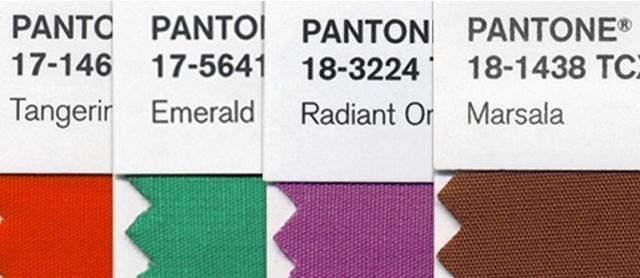So What, Who Cares (vol 1, issue 64) Why you might be inheriting a hoard
Hello! I don't know what it says about me that my pre-storm preparation for #hellastorm 2014 was to go get four bags of Mint Truffle Hershey Kisses and nothing else, but you know, I believe very strongly in the health properties associated with dark chocolate so I'm passing it off as a health move.
How do you prep for inclement weather? Tell me via email or Twitter.
*
We've talked before about senior citizens' downsizing their houses and belongings (vol 1, issue 17) and I've recommended an excellent layperson read on the psychology of acquisition (vol 1, issue 62). For those who don't really want to read a book, may I recommend the New Yorker's excellent article on senior citizens and hoarding? The real point to the article comes at the very end of the well-researched, beautifully organized piece:
The situation is probably going to get worse pretty soon, because of the well-established link between hoarding and aging. By 2050, according to the Census Bureau, the number of Americans age sixty-five or older will be about eighty-four million, almost double what it was in 2012. That’s forty million more people who could end up on the porch holding the plastic bag that the newspaper was delivered in and saying to themselves, “Maybe I should hang on to this.”
So what? This article is one of an increasing body that issues the warning: We are not ready for a critical mass of old people in the U.S.A. It's terrifying enough that we don't have adequate urban infrastructure and that so many senior citizens can't afford to retire (vol 1, issue 61). But now we're facing hoards and the associated health risks, and there aren't enough experts to give families the tools they need to head off this problem.
Who cares? The people who have to handle postmortem disposal of estates? But that's optimistic -- dealing with an elderly hoarder is fraught with stress because anything from helping with health care to providing basic needs like climate control or food is going to be complicated by the hoarding situation.
*

Pantone has veered from the saturated, summery hues of the last few years to dub Marsala (Pantone 18-1438) its color of the year for 2015. (For a visual guide, see right.) This is the sixteenth year Pantone's announced a color of the year for a forthcoming year, and the company says it picked the color to reflect the prevailing organic (vol 1, issue 60), authentic (vol 1, issue 32), farm-to-table (vol 1, issue 16) ethos currently gripping much of consumer culture (vol 1, issue 63) and not, say, because the color looks vaguely like dried blood and we're all obsessed with Serial right now (vol 1, issue 49).
So what? People who want you to keep buying clothing or home goods really set a lot of store by these colors, and Pantone also slinks around brands that might be interested in the color of the year:
Pantone tips off some marketing partners, such as cosmetics retailer Sephora, about the color of the year, so that they can manufacture products in the shade. Sephora is planning a collection of Marsala cosmetics.
People also pay attention because Pantone is the industry heavyweight in providing color standards to all sorts of different design industries. This is why you'll see Marsala popping up everywhere from leather goods to coasters.
Who cares? Do you remember the delightful monologue in The Devil Wears Prada where Miranda Priestly schools Andie on the provenance of her sweater's color? By knowing what colors are being pushed at the top levels of the design process, you can anticipate what you're likely to see in stores for the next year, and you can plan accordingly.
Extra reading: The Connie Willis novel Bellwether is a fast, fun read about a researcher who studies fads and and her attempts to figure out the origins of any given fad. It is a tad dated -- much is made of scanning the personal ads in alt-weeklies as a way to map different fads' ebbs and flows -- but after you read about the breakout fad of Cherenkov blue clothing and how it helps the protagonist come up with a working theory for fad genesis, you will never look at the Pantone color edicts in the same way.
*
Your holiday pop-culture note of the day: A Colbert Christmas: The Greatest Gift of All! is practically the televised embodiment of "What happens when the 2008-era staff of Entertainment Weekly brainstorm a time capsule?" Frajillionaire Toby Keith! Elvis Costello and Willie Nelson so people over age 35 can feel smugly hip! Feist doing her Feist thing! But my favorite number wasn't broadcast; it's the album-only cut "A Cold, Cold Christmas." The way Colbert delivers this stanza:
So cold that it pierces your body
So cold that it hurts every breath
In fact I wouldn't mind if you woke up to find
Your new man had frozen to death
is simply delightful. If you're assembling the "Heartbreak at the holidays" playlist, give this ditty a spot early on to set the mood.
*
Did you miss an issue of So What, Who Cares? The archive is here.
Also, there is now a topic index that tells you what was in each issue. If you're like, "When did she send out a picture of Brandon Routh snuggling a kitty cat?" -- well, now you can find it. (It was November 11, 2014, btw.)
As always, I welcome your feedback and suggestions via email or Twitter. Always let me know what you think about So What, Who Cares? If you really like it, tell a friend to subscribe.



